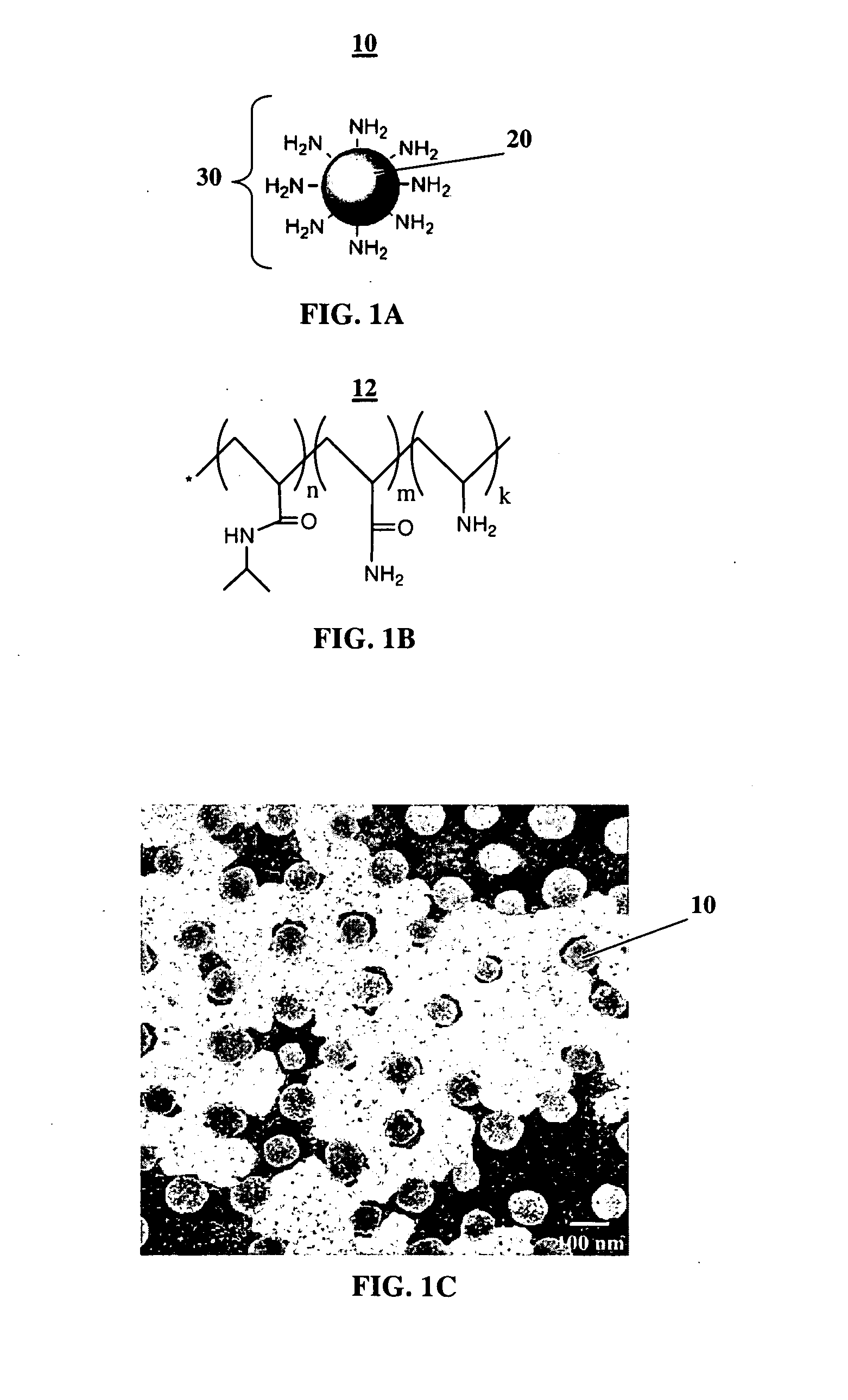Compositions and Methods for Thermo-Sensitive Nanoparticles and Magnetic Nanoparticles
a technology of magnetic nanoparticles and thermo-sensitive nanoparticles, applied in the field of nanoparticles, can solve the problems of ineffective coating, inability to biocompatibility, and difficulty in incorporating other molecules such as antibodies and proteins onto temperature-sensitive nanoparticles to increase their targeted capabilities
- Summary
- Abstract
- Description
- Claims
- Application Information
AI Technical Summary
Problems solved by technology
Method used
Image
Examples
example 1
Shear-Regulated Uptake of Nanoparticles by Endothelial Cells
[0106]The polymer nanoparticles may include targeting, adhesion, and cellular uptake to activated or inflamed endothelial cells (ECs) under physiological flow conditions. Under diseased conditions such as thrombosis, inflammation, and restenosis, ECs become activated and express endothelial cell adhesion molecules (ECAMs) such as P-selectin and E-selectin. The polymer nanoparticles mimic the binding of platelets with activated ECs such as the binding of platelet glycoprotein Ibα (GP Ibα) with P-selectin expressed on activated endothelial cells, GP Ibα-conjugated temperature sensitive nanoparticles exhibit increased targeting and higher cellular uptake in injured or activated endothelial cells under physiological flow conditions.
[0107]Fluorescent carboxylated polystyrene nanoparticles were selected as a model particle. Conjugation of 100 nm polystyrene nanoparticles with glycocalicin (the extracellular segment of platelet GP...
example 2
In Vitro Evaluation of Platelet Mimicking Biodegradable Nanoparticles
[0124]Fluorescent dexamethasone (DEX) was formulated and loaded into poly(D, L-lactic-co-glycolic acid) (PLGA) nanoparticles using the standard double emulsion method. Studies of drug release profiles were conducted and cellular uptake studies in HAECs were analyzed using confocal microscopy, fluorescent measurement and protein assays to determine the optimal incubation time and concentration. The effect shear stress on the nanoparticle adhesion and uptake by the HAECs was studied as well as the effect of GpIbα conjugation of PLGA nanoparticles on the nanoparticle adhesion and targeting to P-selectin and vWF coated surfaces under fluid shear stress. Under shear flow conditions, the uptake of nanoparticles decreases significantly and conjugation of PLGA nanoparticles with glycocalicin (the extracellular segment of platelet GP Ibα) significantly increased the particle adhesion on P-selectin and vWF-coated surfaces un...
example 3
Prostate Specificity of Cell Permeable Peptides (CPPs) R11
[0137]To screen CPPs for optimal intracellular delivery of drugs in prostate cancer cells, FITC-tagged peptides: TAT (G-RKKRRQRRR, SEQ ID NO: 1), PENE (G-RQIKIWFQNRRMKWKK, SEQ ID NO: 2), KALA (G-KLALKLALKALKAALKLA, SEQ ID NO: 3), homopolymers of L-arginine R11 (G-R11), and homopolymers of L-lysine K11 (G-K11) at different concentrations (0, 0.1, 1, 5 μM) were incubated with four prostate cancer cell (PCa) lines (LNCaP, PC3, C4-2, and LAPC4 cells) for 30 minutes, as shown in Zhou, J et al. “Inhibition of Mitogen-Elicited Signal Transduction and Growth in Prostate Cancer with a Small Peptide Derived from the Functional Domain of DOC-2 / DAB2 Delivered by a Unique Vehicle”, Cancer Res 2006; 66: (18) Sep. 15, 2006, incorporated by reference herein. A dose-dependent CPP uptake by four different PCa cells was observed (the fluorescent intensity of cell lysis samples was determined by a fluorometer with excitation 490-500 nm, emission...
PUM
| Property | Measurement | Unit |
|---|---|---|
| Size | aaaaa | aaaaa |
| Volume | aaaaa | aaaaa |
| Volume | aaaaa | aaaaa |
Abstract
Description
Claims
Application Information
 Login to View More
Login to View More - R&D
- Intellectual Property
- Life Sciences
- Materials
- Tech Scout
- Unparalleled Data Quality
- Higher Quality Content
- 60% Fewer Hallucinations
Browse by: Latest US Patents, China's latest patents, Technical Efficacy Thesaurus, Application Domain, Technology Topic, Popular Technical Reports.
© 2025 PatSnap. All rights reserved.Legal|Privacy policy|Modern Slavery Act Transparency Statement|Sitemap|About US| Contact US: help@patsnap.com



